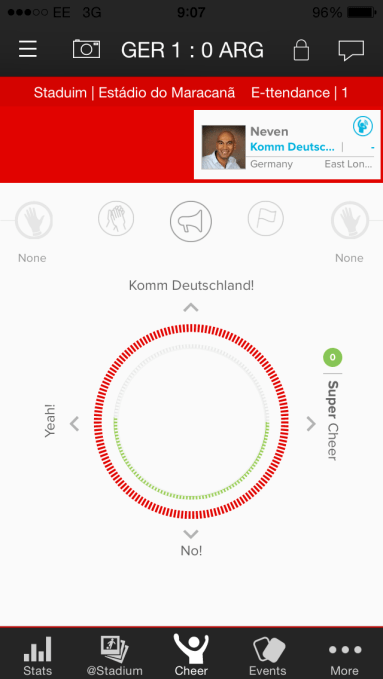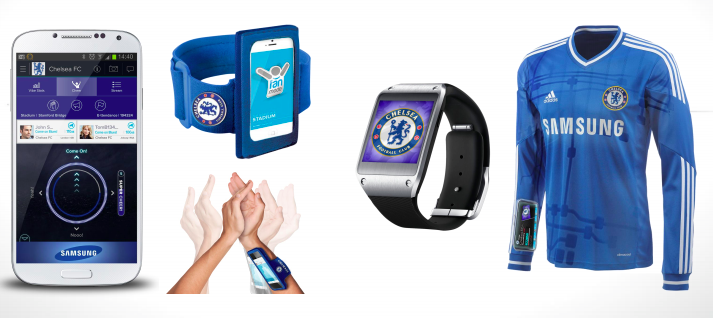Even the most casual sports fan has likely cheered, booed, clapped (or cursed) at their TV during a particularly compelling game. Sport is an emotional business, after all. But, as it stands, there arguably exists a disconnect between fans watching at home or in the many sports bars around the world, and those who are actually at the stadium during a game — as I was yesterday for the Community Shield football, as a guest of Fanmode, a newly launched startup that has set out to solve this ‘problem’.
 Launching first as an iOS and Android app, Fanmode’s flagship feature — and one that gives a glimpse of where the London-based startup is heading — is its gesture-based input that enables fans to express their emotions during a live sporting event, intended for when they aren’t actually at the match but are watching on television. Swipe up to cheer. Swipe down to boo. And, once you’ve accumulated enough points, swipe right for a ‘super cheer’. You can also tap to clap, and wave your phone around in the air as if it’s a flag.
Launching first as an iOS and Android app, Fanmode’s flagship feature — and one that gives a glimpse of where the London-based startup is heading — is its gesture-based input that enables fans to express their emotions during a live sporting event, intended for when they aren’t actually at the match but are watching on television. Swipe up to cheer. Swipe down to boo. And, once you’ve accumulated enough points, swipe right for a ‘super cheer’. You can also tap to clap, and wave your phone around in the air as if it’s a flag.
If this all sounds a tad gimmicky, perhaps it is. But, as the Managing Director of Wembley Stadium, Roger Maslin, told me during the closing minutes of yesterday afternoon’s game, there’s definitely something in the idea.
That’s because all of this fan sentiment data is aggregated in real-time, with the plan being to feed it back live into the stadium and in places that can be seen by the players themselves, such as in the dressing room or tunnel, via screens running Fanmode’s ‘Vibeboard’ dashboard, creating a feedback loop that connects fans closer to the action, no matter where they are watching.

As Fanmode CEO and co-founder Neven Murugan noted when he first conceived of the idea, you can be the biggest fan in the world, but if you only watch at home or in a sports bar, the team you support might not even know you exist.
The business case is arguably clearer: Major sporting events — and, specifically, major football clubs — have long seen their future growth in expanding and nurturing a global fan base. Once you’ve saturated the domestic market, an overseas fan base is where the action (and profit) is at. Just witness, for example, the number of leading UK Premiership football clubs that recently toured the U.S. pre-season.

Another angle and potential reason for something like Fanmode existing, is that so-called ‘big data’ around fan sentiment could be a draw for major brands. One example cited by Fanmode co-founder and Commercial Director Christian Jochnick is that buying decisions (and frequency) can be tied to fan sentiment. If your team loses, you are far less likely to be in a buying mood. Conversely, a win can be correlated with an increase in purchases. That kind of highly targeted ’emotional’ data might be leveraged to ensure a brand is only advertising at the most optimum time. Or so the theory goes.
Wearables
One of the limitations of the Fanmode app (aside from being slightly gimmicky) is the requirement to change your behaviour from the way you would normally express your emotions during a sporting event, even if the app’s gestures attempt to ape those real life actions. It’s here where wearable devices, or something like the Xbox Kinect, might offer a better interface for recording fan sentiment.
Fanmode has already developed an app for Sony’s smart watch and Samsung’s Galaxy Gear 2, while it’s also exploring the idea of a dedicated Fanmode wristband and shirt, too. The idea is to enable emotions to be recorded and fed into Fanmode’s aggregated sentiment data via sensors on wearable devices in a way that is passive and doesn’t require a user to change their match behaviour in any way what so ever.
It’s early days on this front, however, along with the commercial relationships required to close the feedback loop that will see Fanmode data placed in stadiums and potentially on broadcast television.
But, with $2.4 million of freshly closed funding in the bank, announced last week, the startup has bought itself a little more time to figure out how to get there.
